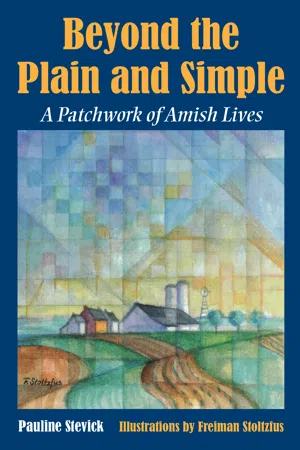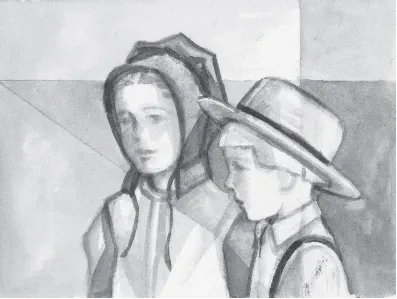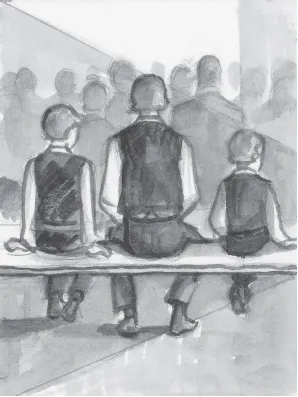![]()
1
Amish Family Values
![]()
Fourteen of us are seated around the supper table in this dimly lit kitchen. My husband and I are guests of this Amish family, a minister and his wife and their ten children. This is our first overnight stay in an Amish home. Four of the younger ones—all boys with blunt haircuts—sit across the table on a wooden bench, their bowed heads in stair-step silhouette against the light from the uncurtained window. At one end of the table are two daughters wearing their white organdy head coverings with narrow untied strings attached. At the other end in a swivel chair sits the father with the baby, a nine-month-old boy in a wooden high chair between him and the mother, with the three-year-old sister on the other side of her. The two oldest sons, young men in their late teens, tanned and muscular from their field work, sit next to my husband and me.
According to Amish custom, the meal begins with silent prayer. Across from me the children sit as motionless as their parents; the only sounds are the ticking of the clock and a few bird calls through the screen door. How do we know when the prayer time is over, I wonder, not wanting to peek lest the children see. Finally the father leans back in his chair, which squeaks slightly, and I know. Sometimes, I learn later, the signal is a gentle sigh.
Daniel, the father, smiles broadly, exposing his white teeth in an expansive welcome. We pass the homemade bread, the Lebanon bologna, the creamed noodles and peas, and the fresh salad made with lettuce gathered from their own garden. We eat in anticipation of the promised dessert, freshly picked strawberries and shortcake.
At times like this, I note, Amish children are truly seen and not heard. They are observers of adult conversation, listening intently in polite silence. Daniel is recalling the recent visit of some members of a Reformed Church from a southern state. I marvel at the interaction, since the ancestors of the Amish were severely persecuted by both Roman Catholics and the Protestant reformers, perhaps even by the ancestors of his Reformed guests. The memory of these persecutions is kept alive by frequent reading from Martyrs Mirror, a book containing accounts of people who were tortured and killed for their religious beliefs during the sixteenth and seventeenth centuries.
Daniel relates how his visitors defended the Roman Catholic and Reformed custom of infant baptism, an important issue since the Amish strongly reject this custom. Instead, they practice believers baptism, which normally takes place during the late teenage years as a distinct choice. Baptism is not something that the parents or the church can do alone but requires the full knowledge and consent of the individual, he explains. During the Reformation the groups that rebaptized adults who confessed their faith in Christ were dubbed “Anabaptists,” which means “rebaptizers.” They are still called that today.
Daniel pauses to butter a slice of bread, folds it, hands it to three-year-old Katie beside him, and continues to explain how his modern-day Reformed visitors had interpreted infant baptism more as dedication, something that must be confirmed later by the children in order to be valid. He is trying to make conversation, I sense—to bridge the gap between the Amish world and ours, his “English” guests. I realize later that the setting is also an indirect catechism class for the listening children.
After we finish our strawberry shortcake, the clatter of plates and tableware stops and the children restrain their wiggling as we bow again for the silent prayer that concludes the meal. This is not the token silent prayer of evangelical custom; instead, we are silent long enough to really pray. I hold my breath, lest I spoil the silence, and listen again for the squeak of Daniel’s chair.
Then fifteen-year-old Emma and ten-year-old Rebecca begin clearing the table and washing the dishes while their brothers, Levi, Noah, Reuben, and Benuel (Ben), head for their chores in the barn. Three-year-old Katie rides her scooter in the area between the house and the barn, keeping up with Samuel and James, the brothers nearest her in age. By now the baby, Danny, is asleep in his crib in his parents’ bedroom.
As dusk descends, we gather in the sitting area off the kitchen. Containing a simple couch and two rocking chairs, it becomes the center for the evening activities. Daniel and Sarah relax as their children play and tussle on the rug beside them. The children read to themselves and each other, listening to the adult conversation, and occasionally entering in. Surely they must sense they are being watched, not only now but throughout our stay, and undoubtedly are putting on their best behavior. Still, I am impressed.
It is a scene I will find repeated with slight variations in other Amish homes. Sometimes after the evening meal, when the dishes are done, the families will play games at the large kitchen table. In one home the mother plays dominoes with the younger children while the older ones teach me a new version of Monopoly. Since the preschool children speak only Pennsylvania Dutch, a colloquial dialect descended from the German of the Palatinate, communication with them on these occasions is limited to a few English words and lots of smiles. The propane lamp hung from the ceiling casts its arc of light on a circle of security and sharing.
The lack of interference from radio, television, or computer games encourages the children to interact with each other, their parents, and us. I am most fascinated with their satisfaction with simple things. In this house there are no Barbie dolls, Beanie Babies, Legos, Gameboys, video games, busy boxes, or plastic ride-on toys. Instead, a few tractors or trucks, a doll or two, and some dog-eared books are enough; rarely do I hear the children beg for more things, although I have heard some beg to be included in an activity. (Later an Amish mother in a different community informed me that her children had Barbie dolls, Beanie Babies, Legos, busy boxes, and ride-on toys and that her children did beg for more things. Apparently communities and families differ, but on the whole, Amish children “make do” with fewer material possessions.)
Soon Sarah announces that it is time for the youngest children to go upstairs to bed, and Daniel hunts for the German prayer book from among the Amish magazines and storybooks on the shelf. Though I understand only a few German words and phrases, I catch the sincerity of tone and demeanor. After prayers Sarah shows us to our bedroom by flashlight and demonstrates how to blow out the kerosene light when we are ready for bed.
We are awakened the next morning before daybreak by the harsh, staccato rhythm of the diesel generator located in the barn, signaling that milking time has arrived and the day’s work has begun. My husband gropes for his flashlight and watch. “Four forty-three,” he groans, leans back on his pillow momentarily, and then lurches out of bed, knowing that if he wants to truly experience Amish life, he must not sleep any later.
During the next few days we observe the interaction of these parents and their children and note how much they value work. Family chores are parceled out according to gender: the girls work in the house and yard and the boys in the barn and fields. This is a well-run household. Sarah is not only mother but also manager, gently directing her children in whatever task is at hand, whether it be preparing for a meal, weeding the garden, or doing the laundry.
Neither she nor her children are overworked. Fifteen-year-old Emma prepares meals very competently, and ten-year-old Rebecca makes “whoopie pies”—sour milk chocolate cookies sandwiched together with a cream filling—with very little supervision. Unbidden she sweeps the kitchen floor after each meal—perhaps because I am present?—taking care not to miss any crumbs. Both girls go about their work without grumbling or rushing their tasks as though they must finish quickly and go on to something else. Yes, I know: they are on their best behavior because of our presence, but they also are contributing to the family’s well-being, and the very doing of the tasks seems fulfilling for them. Probably they would not verbalize this sense of purpose and belonging, but it is apparent in their demeanor and their quiet unself-conscious confidence.
The secret of the children’s attitudes toward work becomes clear in several incidents during our stay. When Sarah asks me to prepare strawberries for supper, I gather the necessary bowls and tools and place them on the kitchen table. As I begin to hull the berries, in comes three-year-old Katie, begging to help. My impulse is to send her away, knowing that her “help” will slow everything down. But Sarah has already lifted her up to the bench and put a plastic bowl in front of her. Placing a berry in her pudgy hand, she shows her how to remove the stem. Katie squashes the berry in the process, then picks up the next berry and tries again. Eventually she learns how. In situations like this, I realize, Amish children are very much both seen and heard.
Out in the barn and the fields my husband experiences the same communal attitude toward work. While in many Amish communities it is now rare for an entire family to work on the farm, this family is fortunate enough to have sufficient means to keep all of their children employed at home—so far. In general, parents prefer to have their offspring work at home where they can learn the value of work while being shielded from outside, “evil” influences. Only after much more contact with Amish families and Amish farms do I understand what Anabaptist historian John L. Ruth meant when he remarked that “the Amish don’t farm to live: they live to farm,” and that “shared work is, in many cases, the Amishman’s recreation.”1
Daniel and his sons are emptying the cow stalls of manure and spreading it on the fields, and while they do not apologize for the unpleasantness of their task, they excuse my husband from participating. He, however, is eager to enter into all aspects of life on an Amish farm, and so is placed under the tutelage of eleven-year-old Ben who has been driving the mules back and forth from barn to field. Just how skillful and responsible Ben is soon becomes apparent to my husband, who asks if he can try to drive the mules pulling the manure spreader. Only after several unsuccessful attempts does he learn when to signal the mules for a turn into the barn. Daniel and the visiting veterinarian have a good laugh about how my husband is probably the only college professor in the state forking manure this bright June morning.
When the six-year-old neglects his task of sweeping out the forebay in the barn, his ten-year-old sister offers to help, but he resists. The father speaks to him softly but firmly in Pennsylvania Dutch, and immediately he is trudging out, broom in hand. Both parents assert that learning to work is essential for children long before they go to school. Sarah remarks to us that the local schoolteacher has commented that she knows which children are accustomed to working by the way in which they attack their schoolwork.
Later Sarah, the older girls, and I scrub down the inside of the section of the barn where the cows are milked, in preparation for the coming Sunday when worship services will be held at their farm. I wonder about the necessity of washing down the cow parlor since the services will either be held in the house or another part of the barn.
As we progress along the milking stalls, we are joined by Katie and James, who beg to help. Again I find myself wanting to shoo them out to play, but Sarah never hesitates. Reaching for a bucket, she explains to Katie how to wash down the walls while sending James for the hose. Of course we and they end up much wetter than we would have without their assistance, but Sarah appears not even to consider the matter. Her unintended lesson is not lost on me: while they are very young the children must learn to be contributing members of the family and the community. If, as has been suggested, two primary goals for humans to achieve are the abilities to love and to work, then the Amish are in the forefront in helping their offspring develop those traits.
But the Amish also teach their children another important lesson that is increasingly neglected in English society: to respect and submit to authority. From the experiences of an acquaintance who also spent some time in an Amish home, I know that the quietness of the children during prayer times before and after meals comes only through deliberate discipline by parents. She observed the efforts of a mother and father who expected their fifteen-month-old child not to fuss during prayer time, and when he did, they waited until he complied. Not only do Amish children learn to work and to love, but they also learn to obey.
This and much more I absorb from our first stay with this Amish family. What I do not know is how important they will become in my life, even though we are separated by over an hour’s drive—and by disparities in culture. We will return again and again to learn from them, counting them among our most admired friends. We will bring our own sons and our friends to visit, sensing that the wisdom of living that our Amish friends embody in many ways surpasses the wisdom of books and degrees.
![]()
2
Three Long Hours of Sitting Still
![]()
The scattered horse droppings and carriage wheel tracks on the pavement reassure me I am headed in the right direction for this summer morning’s Amish church service. Held on alternate Sundays in the homes or barns of members of each district, the Amish church service is a central feature of community life. Although the deacon couple at whose home the service will be conducted have invited my husband and me to attend, we have stayed overnight with another family a few miles away. My husband has preceded me, having left an hour earlier with our host and hostess in their carriage.
I drive past enclaves of houses, barns, and sheds surrounded by tidy gardens and broad fields, their legendary Amish neatness shimmering in the June sunshine. The carriage tracks turn sharply into a lane, and clusters of gray carriages in front of the farmhouse come into view. My husband’s light-blue shirt stands out clearly against the mass of white long-sleeved shirts, black vests and pants, and straw hats. The horses are already quartered in their stalls or tethered under trees. On this warm June morning I note thankfully that the service will be held in the cool basement of the house.
Having previously attended Amish worship services in several settlements, I am familiar with the rituals that are a part of them. Prior to the service, members of the community assemble by age and sex in specially designated areas. The men somberly shake hands with the men, the women with the women, and the men and ministers greet each other with a “holy kiss,” a custom practiced in most Amish communities. In some settlements, the women do this as well. Generally the preservice talking is subdued and sporadic.
Dressed in a blue cotton skirt and white blouse, wearing no makeup and no jewelry except my wedding ring, I join the older women attired in black or dark-colored dresses already seated on plain wooden benches in a corner of the basement. I protest inwardly, “I’m not that old!” Later I realize this is actually a compliment, since they are treating me with the respect reserved for older people in the Amish community.
Soon the younger women enter, several holding babies and some with a toddler or two in tow. Next the older children and the teenage girls process down the basement stairs, silently sliding onto the benches assigned to them, as directed by the woman at whose home the service is being held. Then the bishop, ministers, and deacon enter through a side door, followed by the adult men, some holding children or leading them by the hand. Lastly come the teenage boys with averted eyes, shaking hands with the ministers as they pass through their ranks.
When everyone is seated (close to two hundred of us) the men and boys remove their hats virtually in unison and place them on nails attached to the joists above them or under the benches, except for the ministers who keep theirs on until the first song begins. Few worshipers talk or smile, denoting the seriousness of the occasion. As the somber strains of the first hymn break the summer morning stillness, the ministers, who are seated facing each other on chairs near the center of the assemblage, rise and file out, hats in hand. They will consult each other about aspects of the service before returning.
The congregation sings in unison, as always, ponderously wandering up and down among several notes for each syllable, reminding me of a cross between a bagpipe’s dro...










